International Research Progress in School Travel and Behavior: A Literature Review and Bibliometric Analysis
Abstract
:1. Introduction
2. Methods
| Checklist Item | Treatment Processing |
|---|---|
| Information sources | Web of Science, ScienceDirect, TRID (Transport Research International Documentation), and MEDLINE |
| Search strategy | Subject search = ((“students” OR “children” OR “adolescent” OR “youth” OR “kids”) AND (“school travel” OR “school behavior” OR “school trip” OR “school mode” OR “school journey” OR “mode choice” OR “independent mobility” OR “active school”)) |
| Eligibility criteria |
|
| Selection process | For example: (a) we exclude the route choice and destination choice, which are not consistent with the choice of school travel mode and school travel behaviors studies; (b) systematic reviews were also excluded. |
| Data collection process | The screening process of data is carried out independently by two researchers (the second and third authors). |
| Study risk of bias assessment | Assembled a team that consisted of two researchers and a three-member advisory board. |
| Synthesis methods | The detailed processing before the result is determined is shown in Figure 1. |
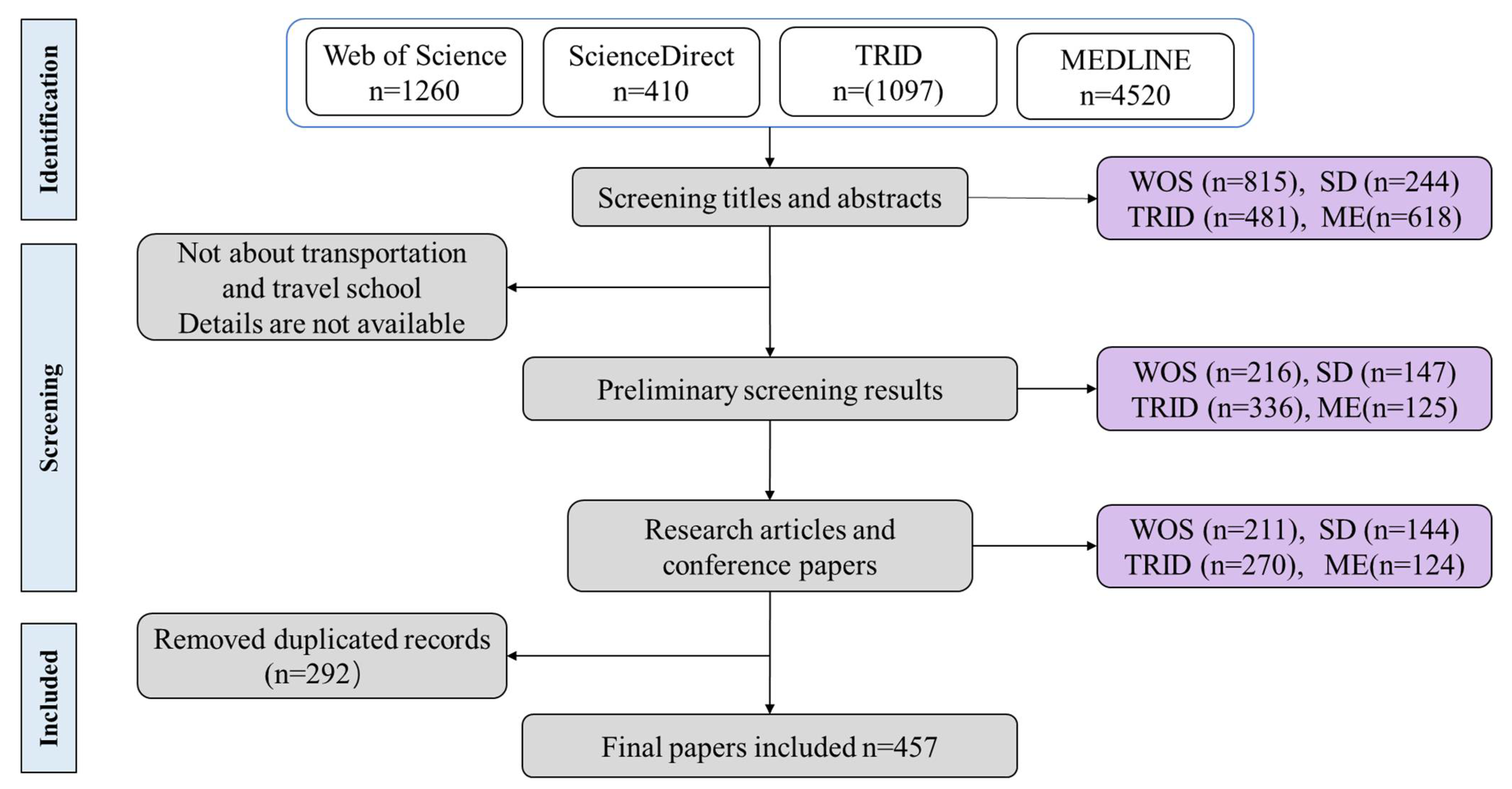
2.1. Search Strategy
- (1)
- “students” OR “children” OR “adolescent” OR “youth” OR “kids”;
- (2)
- “school travel” OR “school behavior” OR “school trip” OR “school mode” OR “school journey” OR “mode choice” OR “independent mobility” OR “active to school”.
2.2. Inclusion Criteria
- (1)
- Publication in peer-reviewed English journals and conferences;
- (2)
- Abstract and full text of articles are available;
- (3)
- Related to do with the field of transportation;
- (4)
- Related to the school travel mode or school travel behavior;
- (5)
- The subjects are elementary, middle, and high school students;
- (6)
- Duplicate papers in the different databases are counted once.
2.3. Study Collection
2.4. Research Method
- (1)
- Constructing similarity matrix
- (2)
- VOSviewer layout method
3. Results
3.1. Overview of the Article Development Trends
3.2. The Performance and Areas and Journals
3.2.1. Analysis of Area Performance
3.2.2. Analysis of Journal Characteristics
3.3. Research Theme
3.3.1. The Analysis of Keywords
3.3.2. The Analysis of Co-Citation Literature
3.4. Top 10 Cited Articles
| Literature | Research Method | Independent | Dependent | Research Area and Subject | Data Type and Sample | Time Cited |
|---|---|---|---|---|---|---|
| Timperio [95] | Pearson chi-square analysis, logistic regression model | personal factors, parental perception, socioeconomic status, neighborhood environment | active commuting to school | Melbourne, Australia (elementary schools) | questionnaires (912) | 539 |
| Mcmillan [4] | binomial logit model | urban form, social\cultural norms, traffic\neighborhood safety, household options, socio- demographics | travel mode to school | Southern California (elementary school) | questionnaire | 365 |
| Kerr [108] | logistic regression | parent concerns, perceived\objective environment, walkability | active commuting to school | Seattle (5–11, 11–18 years) | questionnaires (259) | 361 |
| Schlossberg [104] | chi-square analysis, multinomial logit regression | urban form, distance, route directness | “primary” modes of travel (active transportation to school) | Oregon (four middle schools) | survey (292) | 267 |
| Ewing [117] | multinomial logit model, nested logit model | travel time, built environment, school size, land use | school mode choice | Alachua Country, Florida | regional travel diary surveys a (709) | 250 |
| Mcdonald [27] | multinomial logit model | trip distance, walk travel time, auto travel time, family conditions | mode choice for elementary and middle school children | United States | National Household Travel Survey (4394) | 212 |
| Fyhri [5] | / | distance to school, accompanying children, leisure travel, traffic safety | children’s mobility and activity | Denmark, Finland Great Britain, and Norway | National Travel Survey b | 208 |
| Mcdonald [94] | chi-square test, binary logit model | personal factors, family environment | the mode choice of school travel for family factors | US (elementary middle and high school) | National Household Travel Survey (8231) | 150 |
| Mitra [106] | binomial logistic regression | travel distance, block density, signalized intersections, walking density, low-income neighborhoods | active travel to school | Toronto, Canada Children (11–12 years) | travel data from TTS c (2190) | 141 |
| Yarlagadda [28] | econometric model | characteristics\ parents, built environment, land use | mode choice decisions | San Francisco Bay Area | travel surveys (4352) | 134 |
4. Discussion
4.1. Future Research Work with Sustainability
4.2. Research Limitation
5. Conclusions
Author Contributions
Funding
Institutional Review Board Statement
Informed Consent Statement
Data Availability Statement
Acknowledgments
Conflicts of Interest
References
- Hamidi, S.; Ewing, R.; Preuss, I.; Dodds, A. Measuring Sprawl and Its Impacts: An Update. J. Plan. Educ. Res. 2015, 35, 35–50. [Google Scholar] [CrossRef]
- McMillan, T.E. Urban form and a child’s trip to school: The current literature and a framework for future research. J. Plan. Lit. 2005, 19, 440–456. [Google Scholar] [CrossRef]
- Rothman, L.; MacPherson, A.K.; Ross, T.; Buliung, R.N. The decline in active school transportation (AST): A systematic review of the factors related to AST and changes in school transport over time in North. America. Prev. Med. 2018, 111, 314–322. [Google Scholar] [CrossRef] [PubMed]
- McMillan, T.E. The relative influence of urban form on a child’s travel mode to school. Transp. Res. Part A Policy Pract. 2007, 41, 69–79. [Google Scholar] [CrossRef]
- Fyhri, A.; Hjorthol, R.; Mackett, R.L.; Fotel, T.N.; Kytta, M. Children’s active travel and independent mobility in four countries: Development, social contributing trends and measures. Transp. Policy 2011, 18, 703–710. [Google Scholar] [CrossRef] [Green Version]
- Costa, F.F.; Silva, K.S.; Schmoelz, C.P.; Campos, V.C.; de Assis, M.A.A. Longitudinal and cross-sectional changes in active commuting to school among Brazilian schoolchildren. Prev. Med. 2012, 55, 212–214. [Google Scholar] [CrossRef]
- Leung, K.Y.K.; Loo, B.P.Y. Determinants of children’s active travel to school: A case study in Hong Kong. Travel Behav. Soc. 2020, 21, 79–89. [Google Scholar] [CrossRef]
- Jia, P.; Zhang, L.; Yu, W.; Yu, B.; Liu, M.; Zhang, D.; Yang, S. Impact of COVID-19 lockdown on activity patterns and weight status among youths in China: The COVID-19 Impact on Lifestyle Change Survey (COINLICS). Int. J. Obes. 2021, 45, 695–699. [Google Scholar] [CrossRef]
- Stead, D.; Pojani, D. The urban transport crisis in emerging economies: A comparative overview. In The Urban Transport Crisis in Emerging Economies; Pojani, D., Stead, D., Eds.; Springer International Publishing: Cham, Switzerland, 2017; pp. 283–295. [Google Scholar] [CrossRef]
- Broberg, A.; Sarjala, S. School travel mode choice and the characteristics of the urban built environment: The case of Helsinki, Finland. Transp. Policy 2015, 37, 1–10. [Google Scholar] [CrossRef]
- Loon, J.V.; Frank, L. Urban form relationships with youth physical activity: Implications for research and practice. J. Plan Lit. 2011, 26, 280–308. [Google Scholar] [CrossRef]
- Singh, N.; Vasudevan, V. Understanding school trip mode choice–case of Kanpur (India). J. Trans. Geogr. 2018, 66, 283–290. [Google Scholar] [CrossRef]
- Mackett, R.L. Children’s travel behavior and its health implications. Transp. Policy 2013, 26, 66–72. [Google Scholar] [CrossRef] [Green Version]
- Wilson, E.J.; Wilson, R.; Krizek, K.J. The implications of school choice on travel behavior and environmental emissions. Transp. Res. Part D Transp. Environ. 2007, 12, 506–518. [Google Scholar] [CrossRef]
- World Health Organization. Guidelines on Physical Activity and Sedentary Behaviour; World Health Organization: Geneva, Switzerland, 2020; Available online: https://www.who.int/news-room/fact-sheets/detail/physical-activity (accessed on 4 May 2022).
- Siiba, A. Active travel to school: Understanding the Ghanaian context of the underlying driving factors and the implications for transport planning. J. Transp. Health 2020, 18, 100869. [Google Scholar] [CrossRef]
- Schoeppe, S.; Duncan, M.J.; Badland, H.; Oliver, M.; Curtis, C. Associations of children’s independent mobility and active travel with physical activity, sedentary behavior and weight status: A systematic review. J. Sci. Med. Sport 2013, 16, 312–319. [Google Scholar] [CrossRef]
- Smith, M.; Ikeda, E.; Hawley, G.; Mavoa, S.; Hosking, J.; Egli, V.; Zhao, J.; Mackay, L.; Donnellan, N.; Amann, R.; et al. An integrated conceptual model of environmental needs for New Zealand children’s active travel to school. J. Transp. Health 2020, 16, 100814. [Google Scholar] [CrossRef]
- Ikeda, E.; Stewart, T.; Garrett, N.; Egli, V.; Mandic, S.; Hosking, J.; Witten, K.; Hawley, G.; Tautolo, E.S.; Rodda, J.; et al. Built environment associates of active school travel in New Zealand children and youth: A systematic meta-analysis using individual participant data. J. Transp. Health 2018, 9, 117–131. [Google Scholar] [CrossRef]
- Haddad, H.; de Nazelle, A. The role of personal air pollution sensors and smartphone technology in changing travel behavior. J. Transp. Health 2018, 11, 230–243. [Google Scholar] [CrossRef]
- Mejia, J.F.; Choy, S.L.; Mengersen, K.; Morawska, L. Methodology for assessing exposure and impacts of air pollutants in school children: Data collection, analysis and health effects—A literature review. Atmos. Environ. 2011, 45, 813–823. [Google Scholar] [CrossRef]
- Kuenzli, N.; Bridevaux, P.O.; Liu, L.J.S.; Garcia-Esteban, R.; Schindler, C.; Gerbase, M.W.; Sunyer, J.; Keidel, D.; Rochat, T. Traffic-related air pollution correlates with adult-onset asthma among never-smokers. Thorax 2009, 64, 664–670. [Google Scholar] [CrossRef] [Green Version]
- Chen, P.; Jiao, J.; Xu, M.; Gao, X.; Bischak, C. Promoting active student travel: A longitudinal study. J. Transp. Geogr. 2018, 70, 265–274. [Google Scholar] [CrossRef]
- Lubans, D.R.; Boreham, C.A.; Kelly, P.; Foster, C.E. The relationship between active travel to school and health-related fitness in children and adolescents: A systematic review. Int. J. Behav. Nutr. Phys. Act. 2011, 8, 5. [Google Scholar] [CrossRef] [PubMed] [Green Version]
- Xiaofeng, J.; Qi, Z. Risk assessment and influencing factors of pupils’ school commuting accident risk in school district scale. J. Transp. Syst. Eng. Inf. Technol. 2021, 21, 221–226. (In Chinese) [Google Scholar]
- Park, J.; Kim, B.-I. The school bus routing problem: A review. Eur. J. Oper. Res. 2010, 202, 311–319. [Google Scholar] [CrossRef]
- McDonald, N.C. Children’s mode choice for the school trip: The role of distance and school location in walking to school. Transportation 2008, 35, 23–35. [Google Scholar] [CrossRef]
- Yarlagadda, A.K.; Srinivasan, S. Modeling children’s school travel mode and parental escort decisions. Transportation 2008, 35, 201–218. [Google Scholar] [CrossRef]
- Ermagun, A.; Hossein Rashidi, T.; Samimi, A. A joint model for mode choice and escort decisions of school trips. Transp. A Transp. Sci. 2015, 11, 270–289. [Google Scholar] [CrossRef]
- Jason, C. Examining the relationship between neighbohood built environment and travel behavior: A review from the US perspective. Urban Plan. Int. 2015, 30, 46–52. (In Chinese) [Google Scholar]
- Ross, T.; Buliung, R. A systematic review of disability’s treatment in the active school travel and children’s independent mobility literatures. Transp. Rev. 2017, 38, 349–371. [Google Scholar] [CrossRef]
- Amin, T.; Khan, F.; Amyotte, P. A bibliometric review of process safety and risk analysis. Process Saf. Environ. Prot. 2019, 126, 366–381. [Google Scholar] [CrossRef]
- Begeny, J.C.; Levy, R.A.; Hida, R.; Norwalk, K.; Field, S.; Suzuki, H.; Soriano-Ferrer, M.; Scheunemann, A.; Guerrant, M.; Clinton, A.; et al. Geographically representative scholarship and internationalization in school and educational psychology: A bibliometric analysis of eight journals from 2002–2016. J. Sch. Psychol. 2018, 70, 44–63. [Google Scholar] [CrossRef] [PubMed]
- Modak, N.M.; Merigó, J.M.; Weber, R.; Manzor, F.; de Dios Ortúzar, J. Fifty years of Transportation Research journals: A bibliometric overview. Transp. Res. Pol. Pract. 2019, 120, 188–223. [Google Scholar] [CrossRef]
- Liu, W.; Wang, J.; Li, C.; Chen, B.; Sun, Y. Using bibliometric analysis to understand the recent progress in agroecosystem services research. Ecol. Econ. 2019, 156, 293–305. [Google Scholar] [CrossRef]
- Parish, C.M.; Edmondson, P.D. Data visualization heuristics for the physical sciences. Mater. Des. 2019, 179, 107868. [Google Scholar] [CrossRef]
- Sharifi, A.; Allam, Z.; Feizizadeh, B.; Ghamari, H. Three Decades of Research on Smart Cities: Mapping Knowledge Structure and Trends. Sustainability 2021, 13, 7140. [Google Scholar] [CrossRef]
- Sun, L.J.; Rahwan, I. Coauthorship network in transportation research. Transp. Res. Part A Policy Pract. 2017, 100, 135–151. [Google Scholar] [CrossRef]
- Ersoy Mirici, M. The Ecosystem Services and Green Infrastructure: A Systematic Review and the Gap of Economic Valuation. Sustainability 2022, 14, 517. [Google Scholar] [CrossRef]
- Davarzani, H.; Fahimnia, B.; Bell, M.; Sarkis, J. Greening ports and maritime logistics: A review. Transp. Res. Part D Transp. Environ. 2016, 48, 473–487. [Google Scholar] [CrossRef]
- Bataglin, J.C.; Kruglianskas, I. Social Innovation: Field Analysis and Gaps for Future Research. Sustainability 2022, 14, 1153. [Google Scholar] [CrossRef]
- Broadus, R.N. Toward a definition of “Bibliometrics”. Scientometrics 1987, 12, 373–379. [Google Scholar] [CrossRef]
- Page, M.J.; McKenzie, J.E.; Bossuyt, P.M.; Boutron, I.; Hoffmann, T.C.; Mulrow, C.D.; Shamseer, L.; Tetzlaff, J.M.; Akl, E.A.; Brennan, S.E.; et al. The PRISMA 2020 statement: An updated guideline for reporting systematic reviews. Int. J. Surg. 2021, 88, 105906. [Google Scholar] [CrossRef] [PubMed]
- Tranfield, D.; Denyer, D.; Smart, P. Towards a methodology for developing evidence-informed management knowledge by means of systematic review. Br. J. Manag. 2003, 14, 207–222. [Google Scholar] [CrossRef]
- Savoy, J. Bibliographic database access using free-text and controlled vocabulary: An evaluation. Inf. Process. Manag. 2005, 41, 873–890. [Google Scholar] [CrossRef]
- Sun, B.; Park, B.B. Route choice modeling with support vector machine. Transp. Res. Procedia 2017, 25, 1811–1819. [Google Scholar] [CrossRef]
- Rinaldi, M.; Tampere, C.M.; Viti, F. On characterizing the relationship between route choice behaviour and optimal traffic control solution space. Transp. Res. Part B Methodol. 2017, 117, 892–906. [Google Scholar] [CrossRef]
- Leung, A.; Burke, M.; Cui, J.; Perl, A. Fuel price changes and their impacts on urban transport—A literature review using bibliometric and content analysis techniques, 1972–2017. Transp. Rev. 2019, 39, 463–484. [Google Scholar] [CrossRef] [Green Version]
- Aboelela, S.W.; Larson, E.; Bakken, S.; Carrasquillo, O.; Formicola, A.; Glied, S.A.; Haas, J.; Gebbie, K.M. Defining interdisciplinary research: Conclusions from a critical review of the literature. Health Serv. Res. 2007, 42, 329–346. [Google Scholar] [CrossRef] [Green Version]
- Xu, Z.; Wang, X.; Wang, X.; Skare, M. A comprehensive bibliometric analysis of entrepreneurship and crisis literature published from 1984 to 2020. J. Bus. Res. 2021, 135, 304–318. [Google Scholar] [CrossRef]
- Donthu, N.; Kumar, S.; Pandey, N.; Pandey, N.; Mishra, A. Mapping the electronic word-of-mouth (eWOM) research: A systematic review and bibliometric analysis. J. Bus. Res. 2021, 135, 758–773. [Google Scholar] [CrossRef]
- Pilkington, A.; Meredith, J. The evolution of the intellectual structure of operations management-1980–2006: A citation/co-citation analysis. J. Oper. Manag. 2008, 27, 185–202. [Google Scholar] [CrossRef]
- Battiston, F.; Nicosia, V.; Latora, V. Structural measures for multiplex networks. Phys. Rev. E 2014, 89, 032804. [Google Scholar] [CrossRef] [PubMed] [Green Version]
- Tsiotas, D.; Polyzos, S. Decomposing multilayer transportation networks using complex network analysis: A case study for the Greek aviation network. J. Complex Netw. 2015, 3, 642–670. [Google Scholar] [CrossRef]
- Shiffrin, R.; Bomer, K. Mapping knowledge domains. Proc. Natl. Acad. Sci. USA 2004, 101, 5183–5185. [Google Scholar] [CrossRef] [Green Version]
- Van Eck, N.J.; Waltman, L. Software survey: VOSviewer, a computer program for bibliometric mapping. Scientometrics 2010, 84, 523–538. [Google Scholar] [CrossRef] [Green Version]
- Wang, H.; Yang, Y. Neighbourhood walkability: A review and bibliometric analysis. Cities 2019, 93, 43–61. [Google Scholar] [CrossRef]
- Jian, F.; Jingda, D. Comparison of Visualization Principles between Citespace and VOSviewer. J. Lib. Inf. Sci. Agric. 2019, 31, 31–37. [Google Scholar] [CrossRef]
- Bamel, U.K.; Pandey, R.; Gupta, A. Safety climate: Systematic literature network analysis of 38 years (1980–2018) of research. Accid. Anal. Prev. 2019, 135, 105387. [Google Scholar] [CrossRef]
- Clifton, K. Independent mobility among teenagers: Exploration of travel to after-school activities. Transp. Res. Rec. 2003, 1854, 74–80. [Google Scholar] [CrossRef]
- Larsen, K.; Buliung, R.N.; Faulkner, G. Safety and school travel: How does the built environment relate to correlates of safety, node of travel and physical activity levels to and from School. Transp. Res. Rec. 2015, 2513, 80–89. [Google Scholar] [CrossRef]
- Hsu, H.-P.; Saphores, J.-D. Impacts of parental gender and attitudes on children’s school travel mode and parental chauffeuring behavior: Results for California based on the 2009 National Household Travel Survey. Transportation 2014, 41, 543–565. [Google Scholar] [CrossRef]
- Whalen, K.E.; Páez, A.; Carrasco, J.A. Mode choice of university students commuting to school and the role of active travel. J. Transp. Geogr. 2013, 31, 132–142. [Google Scholar] [CrossRef]
- Yang, X.J. China’s rapid urbanization. Science 2013, 342, 310. [Google Scholar] [CrossRef] [PubMed]
- Ergun, A.; Samimi, A. Promoting active transportation modes in school trips. Transp. Policy 2015, 37, 203–211. [Google Scholar] [CrossRef]
- Zhou, H.; Yang, J.; Hsu, P.; Chen, S. Factors affecting students’ walking/biking rates: Initial findings from a Safe Route to School survey in Florida. J. Transp. Saf. Secur. 2010, 2, 14–27. [Google Scholar] [CrossRef]
- Fischbeck, P.S.; Huey, B.M. The relative risks of school travel: A national perspective and guidance for local community risk assessment. Transp. Res. Rec. 2003, 224, 39–42. [Google Scholar] [CrossRef]
- Guliani, A.; Mitra, R.; Buliung, R.N.; Larsen, K.; Faulkner, G.E. Gender-based differences in school travel mode choice behavior: Examining the relationship between the neighborhood environment and perceived traffic safety. J. Transp. Health 2015, 2, 502–511. [Google Scholar] [CrossRef]
- Sener, I.N.; Lee, R.J.; Sidharthan, R. An examination of children’s school travel: A focus on active travel and parental effects. Transp. Res. Part A Policy Pract. 2018, 123, 24–34. [Google Scholar] [CrossRef]
- Liu, Y.; Ji, Y.; Liu, Q.; He, M.; Ma, X. Investigating electric bicycles as a travel mode choice for escorting children to school: A case study in Kunming, China. Transp. Res. Rec. 2017, 2634, 8–16. [Google Scholar] [CrossRef]
- Keall, M.; Hopkins, D.; Coppell, K.; Sandretto, S.; Bengoechea, E.G.; Spence, J.; Wilson, G.; Mandic, S. Implications of attending the closest school on adolescents’ physical activity and car travel in Dunedin, New Zealand. J. Transp. Health 2020, 18, 100900. [Google Scholar] [CrossRef]
- Fast, I. Unequal traveling: How school district and family characteristics shape the duration of students’ commute to school. Travel. Behav. Soc. 2020, 20, 165–173. [Google Scholar] [CrossRef]
- United Nations International Children’s Emergency Fund (UNICEF). What Is a Child-Friendly City? Available online: https://childfriendlycities.org/what-is-a-child-friendly-city/ (accessed on 14 July 2022).
- Zhao, J.; Su, W.; Luo, J.; Zuo, J. Evaluation and Optimization of Walkability of Children’s School Travel Road for Accessibility and Safety Improvement. Int. J. Environ. Res. Public Health 2021, 19, 71. [Google Scholar] [CrossRef] [PubMed]
- Xu, M.; Shen, Y.; Liao, Y.; Woolley, H. Evaluation Indicators of Children’s Mobility Safety in the Community Environment Based on English Literature Review. Landsc. Archit. Front. 2020, 8, 10–25. [Google Scholar] [CrossRef]
- Hatamzadeh, Y.; Habibian, M.; Khodaii, A. Effective factors in walking mode choice of different age groups for school trips. Transp. Res. Procedia 2017, 25, 2302–2313. [Google Scholar] [CrossRef]
- Mcdonald, N.C. Active transportation to school: Trends among U.S. schoolchildren, 1969–2001 ScienceDirect. Am. J. Prev. Med. 2007, 32, 509–516. [Google Scholar] [CrossRef] [PubMed]
- Sidharthan, R.; Bhat, C.R.; Pendyala, R.M.; Goulias, K.G. Model for children’s school travel mode choice. Transp. Res. Rec. 2011, 2213, 78–86. [Google Scholar] [CrossRef] [Green Version]
- Dale, D.; Corbin, C.B.; Dale, K.S. Restricting opportunities to be active during school time: Do children compensate by increasing physical activity levels after school. Res. Q. Exerc. Sport 2000, 71, 240–248. [Google Scholar] [CrossRef]
- Katapally, T.R. Report card grades on the physical activity of children and youth comparing 30 very high human development index countries. J. Phys. Act. Health 2018, 15, S298–S314. [Google Scholar] [CrossRef] [Green Version]
- Stark, J.; Meschik, M.; Singleton, P.A.; Schützhofer, B. Active school travel, attitudes and psychological well-being of children. Transp. Res. Part F Traffic Psychol. Behav. 2018, 56, 453–465. [Google Scholar] [CrossRef]
- Pabayo, R.; Gauvin, L.; Barnett, T.A. Longitudinal changes in active transportation to school in Canadian youth aged 6 through 16 years. Pediatrics 2011, 128, e404–e413. [Google Scholar] [CrossRef]
- Lau, E.Y.; Faulkner, G.; Riazi, N.; Qian, W.; Leatherdale, S.T. An examination of how changing patterns of school travel mode impact moderate-to-vigorous physical activity among adolescents over time. J. Transp. Health 2017, 6, 299–305. [Google Scholar] [CrossRef]
- Stewart, O. Findings from research on active transportation to school and implications for safe routes to school programs. J. Plan. Lit. 2011, 316, 127–150. [Google Scholar] [CrossRef]
- Easton, S.; Ferrari, E. Children’s travel to school the interaction of individual, neighborhood and school factors. Transp. Policy 2015, 44, 9–18. [Google Scholar] [CrossRef] [Green Version]
- Lu, W.; McKyer, E.L.J.; Lee, C.; Goodson, P.; Ory, M.G.; Wang, S. Perceived barriers to children’s active commuting to school: A systematic review of empirical, methodological and theoretical evidence. Int. J. Behav. Nutr. Phy. Act. 2014, 11, 1–20. [Google Scholar] [CrossRef] [PubMed] [Green Version]
- Race, D.L.; Sims-Gould, J.; Lee, N.C.; Frazer, A.D.; Voss, C.; Naylor, P.J.; McKay, H.A. Urban and suburban children’s experiences with school travel—A case study. J. Transp. Health 2017, 4, 305–315. [Google Scholar] [CrossRef]
- Kemperman, A.; Timmermans, H. Environmental correlates of active travel behavior of children. Environ. Behav. 2014, 46, 583–608. [Google Scholar] [CrossRef]
- Clark, A.; Scott, D. Understanding the impact of the modifiable areal unit problem on the relationship between active travel and the built environment. Urban Stud. 2014, 51, 284–299. [Google Scholar] [CrossRef]
- Small, H. Co-citation in the scientific literature: A new measure of the relationship between two documents. J. Am. Soc. Inf. Sci. 1973, 24, 265–269. [Google Scholar] [CrossRef]
- White, H.D.; Griffith, B.C. Author cocitation: A literature measure of intellectual structure. J. Am. Soc. Inf. Sci. 1981, 32, 163–171. [Google Scholar] [CrossRef]
- Gao, C.; Sun, M.; Shen, B. Features and evolution of international fossil energy trade relationships: A weighted multilayer network analysis. Appl. Energy 2015, 156, 542–554. [Google Scholar] [CrossRef]
- van Eck, N.J.; Waltman, L. VOSviewer Manual Version 1.6.16; University Leiden: Leiden, The Netherlands, 2020. [Google Scholar]
- Noreen, C. McDonald. Household interactions and children’s school travel: The effect of parental work patterns on walking and biking to school. J. Transp. Geogr. 2008, 16, 324–331. [Google Scholar] [CrossRef]
- Timperio, A.; Ball, K.; Salmon, J.; Roberts, R.; Giles-Corti, B.; Simmons, D.; Baur, L.; Crawford, D. Personal, family, social, and environmental correlates of active commuting to school. Am. J. Prev. Med. 2006, 30, 45–51. [Google Scholar] [CrossRef] [PubMed]
- Kelly, J.A.; Fu, M. Sustainable school commuting—Understanding choices and identifying opportunities: A case study in Dublin, Ireland. J. Transp. Geogr. 2014, 34, 221–230. [Google Scholar] [CrossRef]
- Mitra, R.; Buliung, R.N. The influence of neighborhood environment and household travel interactions on school travel behavior: An exploration using geographically-weighted models. J. Transp. Geogr. 2014, 36, 69–78. [Google Scholar] [CrossRef]
- Fusco, C.; Moola, F.; Faulkner, G.; Buliung, R.; Richichi, V. Toward an understanding of children’s perceptions of their transport geographies: (non)active school travel and visual representations of the built environment. J. Transp. Geogr. 2012, 20, 62–70. [Google Scholar] [CrossRef]
- Sirard, J.R.; Slater, M.E. Walking and bicycling to school: A review. Am. J. Lifestyle Med. 2008, 2, 372–396. [Google Scholar] [CrossRef]
- Faulkner, G.E.; Buliung, R.N.; Flora, P.K.; Fusco, C. Active school transport, physical activity levels and body weight of children and youth: A systematic review. Prev. Med. 2009, 48, 3–8. [Google Scholar] [CrossRef]
- Mackett, R.; Lucas, L.; Paskins, J.; Turbin, J. The therapeutic value of children’s everyday travel. Transp. Res. Part A Policy Pract. 2005, 39, 205–219. [Google Scholar] [CrossRef]
- Mammen, G.; Stone, M.R.; Buliung, R.; Faulkner, G. School travel planning in Canada: Identifying child, family, and school-level characteristics associated with travel mode shift from driving to active school travel. J. Transp. Health 2014, 1, 288–294. [Google Scholar] [CrossRef]
- Kamargianni, M.; Dubey, S.; Polydoropoulou, A.; Bhat, C. Investigating the subjective and objective factors influencing teenagers’ school travel mode choice—An integrated choice and latent variable model. Transp. Res. A Policy Pract. 2015, 78, 473–488. [Google Scholar] [CrossRef] [Green Version]
- Schlossberg, M.; Greene, J.; Phillips, P.P.; Johnson, B.; Parker, B. School trips: Effects of urban form and distance on travel mode. J. Am. Plan. Assoc. 2006, 72, 337–346. [Google Scholar] [CrossRef]
- Carlson, J.A.; Sallis, J.F.; Kerr, J.; Conway, T.L.; Cain, K.; Frank, L.D.; Saelens, B.E. Built environment characteristics and parent active transportation areassociated with active travel to school in youth age 12–15. Br. J. Sports Med. 2014, 48, 1634–1639. [Google Scholar] [CrossRef] [PubMed]
- Mitra, R.; Buliung, R.N. Built environment correlates of active school transportation: Neighborhood and the modifiable areal unit problem. J. Transp. Geogr. 2012, 20, 51–61. [Google Scholar] [CrossRef]
- Larsen, K.; Gilliland, J.; Hess, P.; Tucker, P.; Irwin, J.; He, M. The influence of the physical environment and sociodemographic characteristics on children’s mode of travel to and from school. Am. J. Public Health 2009, 99, 520–526. [Google Scholar] [CrossRef]
- Kerr, J.; Rosenberg, D.; Sallis, J.F.; Saelens, B.E.; Frank, L.D.; Conway, T.L. Active commuting to school: Associations with environment and parental concerns. Med. Sci. Sports Exerc. 2006, 38, 787–794. [Google Scholar] [CrossRef] [PubMed]
- Oliver, M.; Witten, K.; Kearns, R.; Mavoa, S. Kids in the city study: Research design and methodology. BMC Public Health 2011, 11, 1–12. [Google Scholar] [CrossRef] [PubMed] [Green Version]
- Rothman, L.; Buliung, R.; Macarthur, C.; Macpherson, A.; Howard, A. Associations between parent perception of traffic danger, the built environment and walking to school. J. Transp. Health 2015, 2, 327–335. [Google Scholar] [CrossRef]
- Ermagun, A.; Levinson, D. Public transit, active travel, and the journey to school: A cross-nested logit analysis. Transp. A Transp. Sci. 2016, 13, 1–16. [Google Scholar] [CrossRef]
- Giles-Corti, B.; Kelty, S.; Zubrick, S.; Villanueva, K. Encouraging walking for transport and physical activity in children and adolescents. Sports Med. 2009, 39, 995–1009. [Google Scholar] [CrossRef]
- Mandic, S.; Hopkins, D.; Bengoechea, E.G.; Flaherty, C.; Williams, J.; Sloane, L.; Moore, A.; Spence, J.C. Adolescents’ perceptions of cycling versus walking to school: Understanding the New Zealand context. J. Transp. Health 2017, 4, 294–304. [Google Scholar] [CrossRef]
- Draft Auckland Regional Land Transport Plan 2018–2028; Auckland Transport: Auckland, New Zealand, 2018; p. 77.
- Global Action Plan on Physical Activity 2018–2030: More Active People for a Healthier World; World Health Organization: Geneva, Switzerland, 2018; p. 104.
- Ermagun, A.; Rashidi, T.H.; Lari, Z.A. Mode choice for school trips: Long-term planning and impact of modal specification on policy assessments. Transp. Res. Rec. 2015, 2513, 97–105. [Google Scholar] [CrossRef]
- Ewing, R.; Schroeer, W.; Greene, W. School location and student travel analysis of factors affecting mode choice. Transp. Res. Rec. 2004, 1895, 55–63. [Google Scholar] [CrossRef]
- Li, W.; Zhao, S.; Ma, J.; Qin, W. Investigating Regional and Generational Heterogeneity in Low-Carbon Travel Behavior Intention Based on a PLS-SEM Approach. Sustainability 2021, 13, 3492. [Google Scholar] [CrossRef]
- McDonald, N.C.; Barth, P.H.; Steiner, R.L. Assessing the distribution of safe routes to school program funds, 2005–2012. Am. J. Prev. Med. 2013, 45, 401–406. [Google Scholar] [CrossRef]
- Staunton, C.E.; Hubsmith, D.; Kallins, W. Promoting safe walking and biking to school: The Marin County success story. Am. J. Public Health 2003, 93, 1431–1434. [Google Scholar] [CrossRef] [PubMed]
- McDonald, N.; Aalborg, A.E. Why parents drive children to school: Implications for safe routes to school programs. J. Am. Plan. Assoc. 2009, 75, 331–342. [Google Scholar] [CrossRef]
- Eing, R. Travel and the built environment: A synthesis. Transp. Res. Rec. 2001, 1780, 265–294. [Google Scholar] [CrossRef] [Green Version]
- Muller, S.; Mejia-Dorantes, L.; Kersten, E. Analysis of active school transportation in hilly urban environments: A case study of Dresden. J. Trans. Geogr. 2020, 88, 102872. [Google Scholar] [CrossRef]
- Mandic, S.; Sandretto, S.; García Bengoechea, E.; Hopkins, D.; Moore, A.; Rodda, J.; Wilson, G. Enrolling in the Closest School or Not? Implications of school choice decisions for active transport to school. J. Transp. Health 2017, 6, 347–357. [Google Scholar] [CrossRef]
- Murtagh, E.; Dempster, M.; Murphy, M. Determinants of uptake and maintenance of active commuting to school. Health Place 2016, 40, 9–14. [Google Scholar] [CrossRef] [Green Version]
- Carlson, S.A.; Guide, R.; Schmid, T.L.; Moore, L.V.; Barradas, D.T.; Fulton, J.E. Public Support for Street-Scale Urban Design Practices and Policies to Increase Physical Activity. J. Phys. Act. Health 2011, 8, S125–S134. [Google Scholar] [CrossRef]
- Handy, S.; Sallis, J.F.; Weber, D.; Maibach, E.; Hollander, M. Is Support for Traditionally Designed Communities Growing? Evidence From Two National Surveys. J. Am. Plan. Assoc. 2008, 74, 209221. [Google Scholar] [CrossRef]
- Frank, L.D.; Saelens, B.E.; Powell, K.E.; Chapman, J.E. Stepping towards causation: Do built environments or neighborhood and travel preferences explain physical activity, driving, and obesity? Soc. Sci. Med. 2007, 65, 1898–1914. [Google Scholar] [CrossRef] [PubMed]
- Smith, M.; Hosking, J.; Woodward, A.; Witten, K.; Macmillan, A.; Field, A.; Baas, P.; Mackie, H. Systematic literature review of built environment effects on physical activity and active transport – an update and new findings on health equity. Int. J. Behav. Nutr. Phys. Act. 2017, 14, 1–27. [Google Scholar] [CrossRef] [PubMed]
- Chriqui, J.F.; Taber, D.R.; Slater, S.J.; Turner, L.; Lowrey, K.M.; Chaloupka, F.J. The impact of state safe routes to school-related laws on active travel to school policies and practices in US elementary schools. Health Place 2012, 18, 8–15. [Google Scholar] [CrossRef] [Green Version]
- Giles-Corti, B.; Sallis, J.F.; Sugiyama, T.; Frank, L.D.; Lowe, M.; Owen, N. Translating active living research into policy and practice: One important pathway to chronic disease prevention. J. Public Health Policy 2015, 36, 231–243. [Google Scholar] [CrossRef]
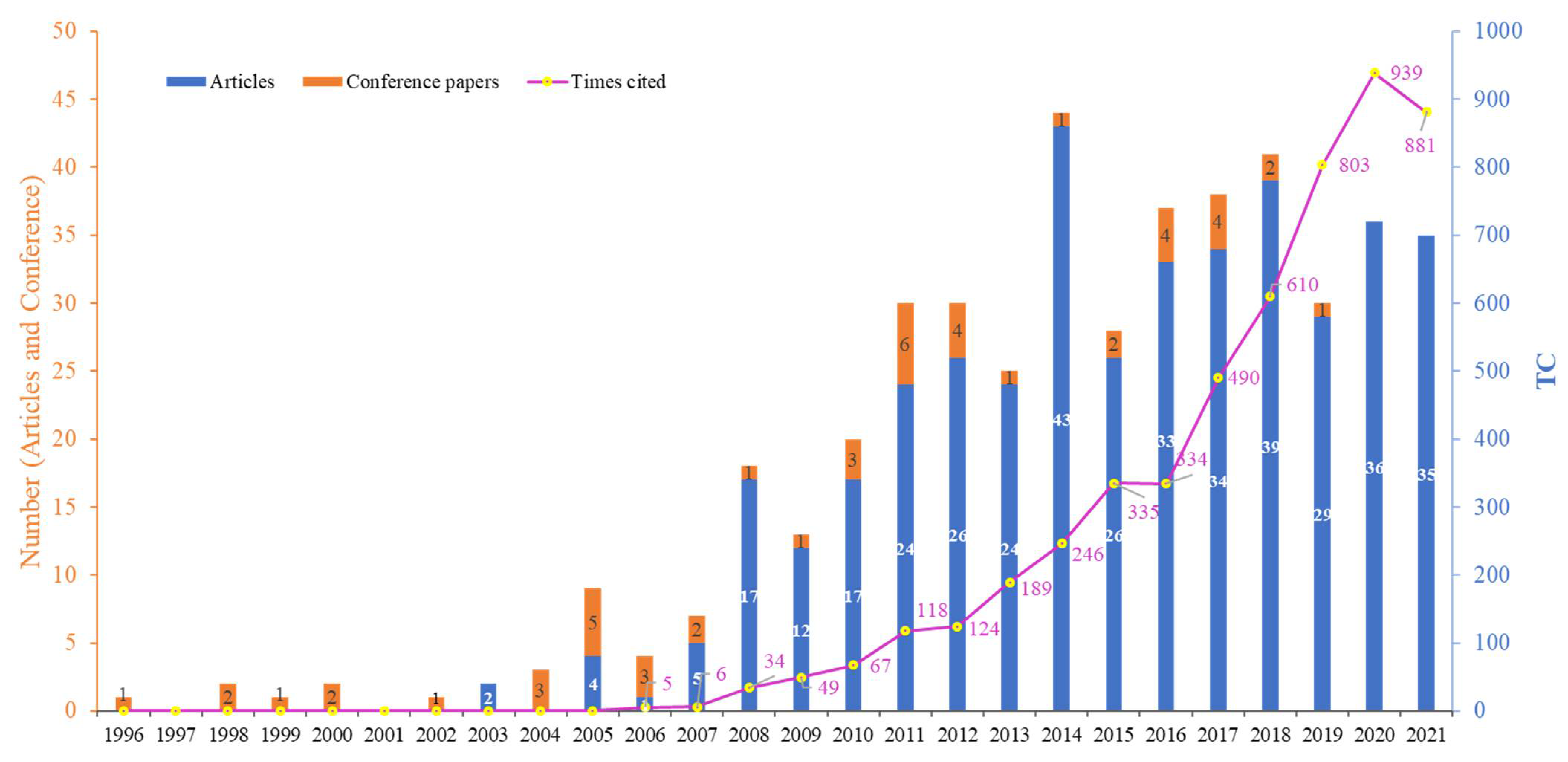
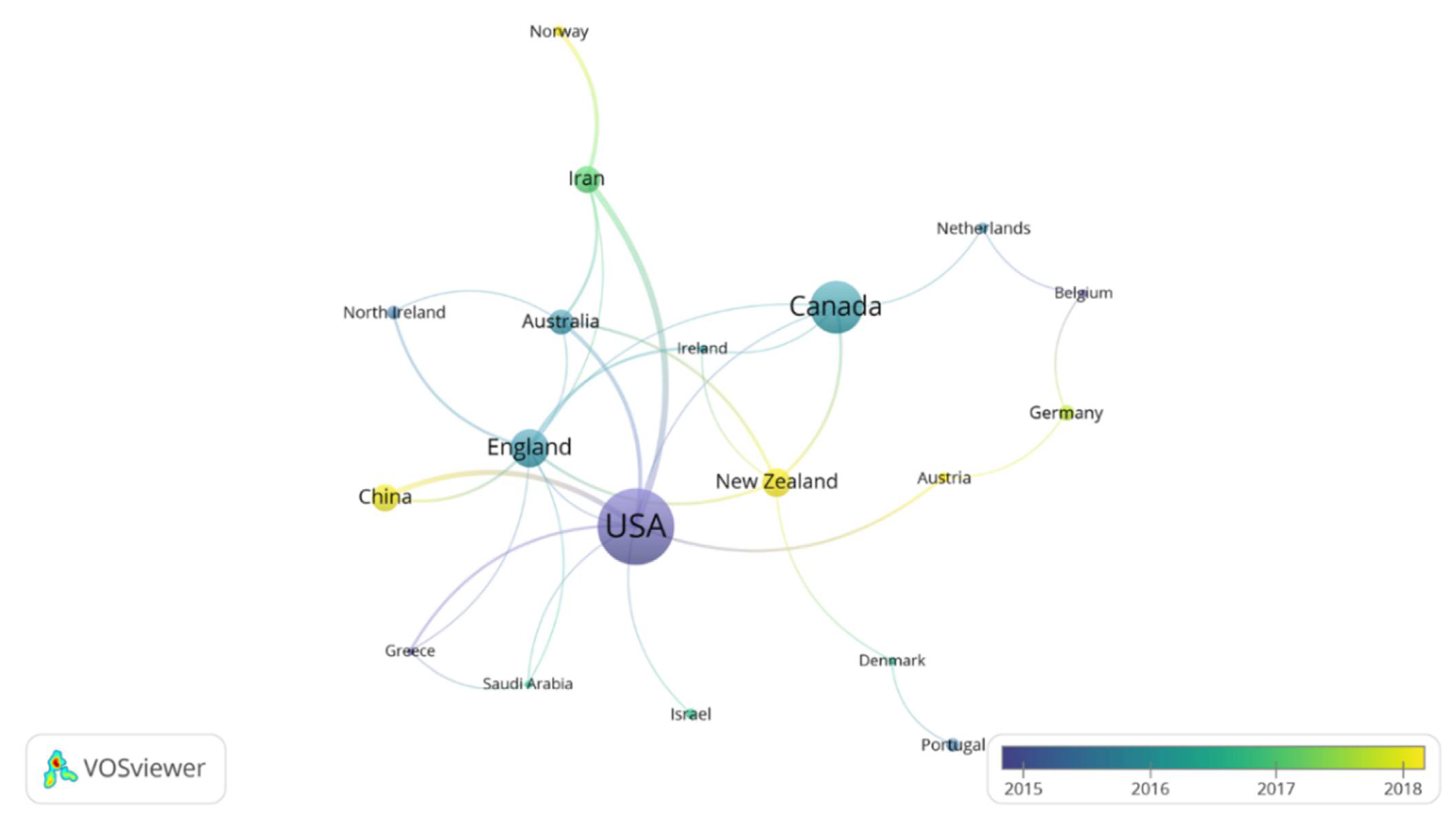
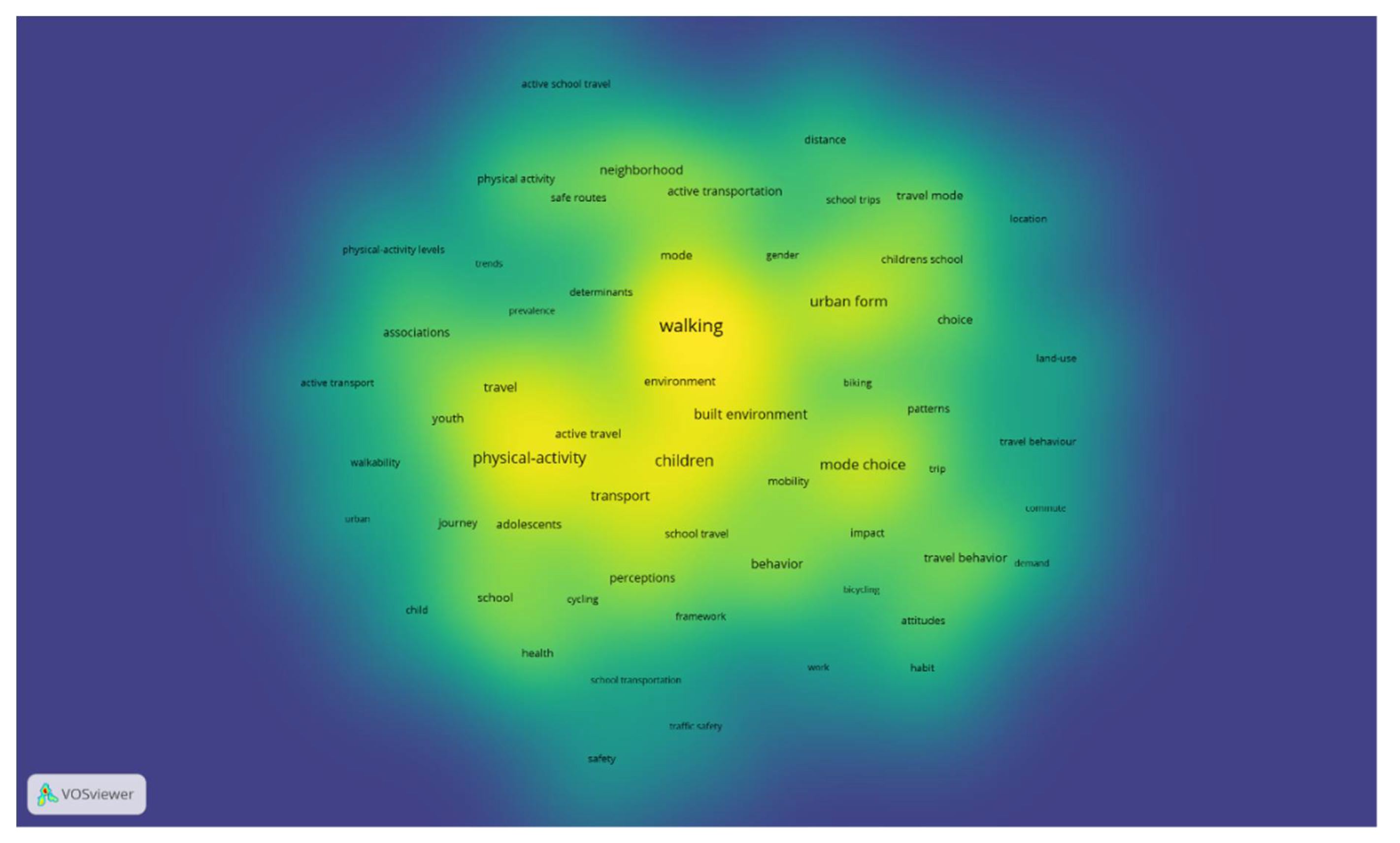
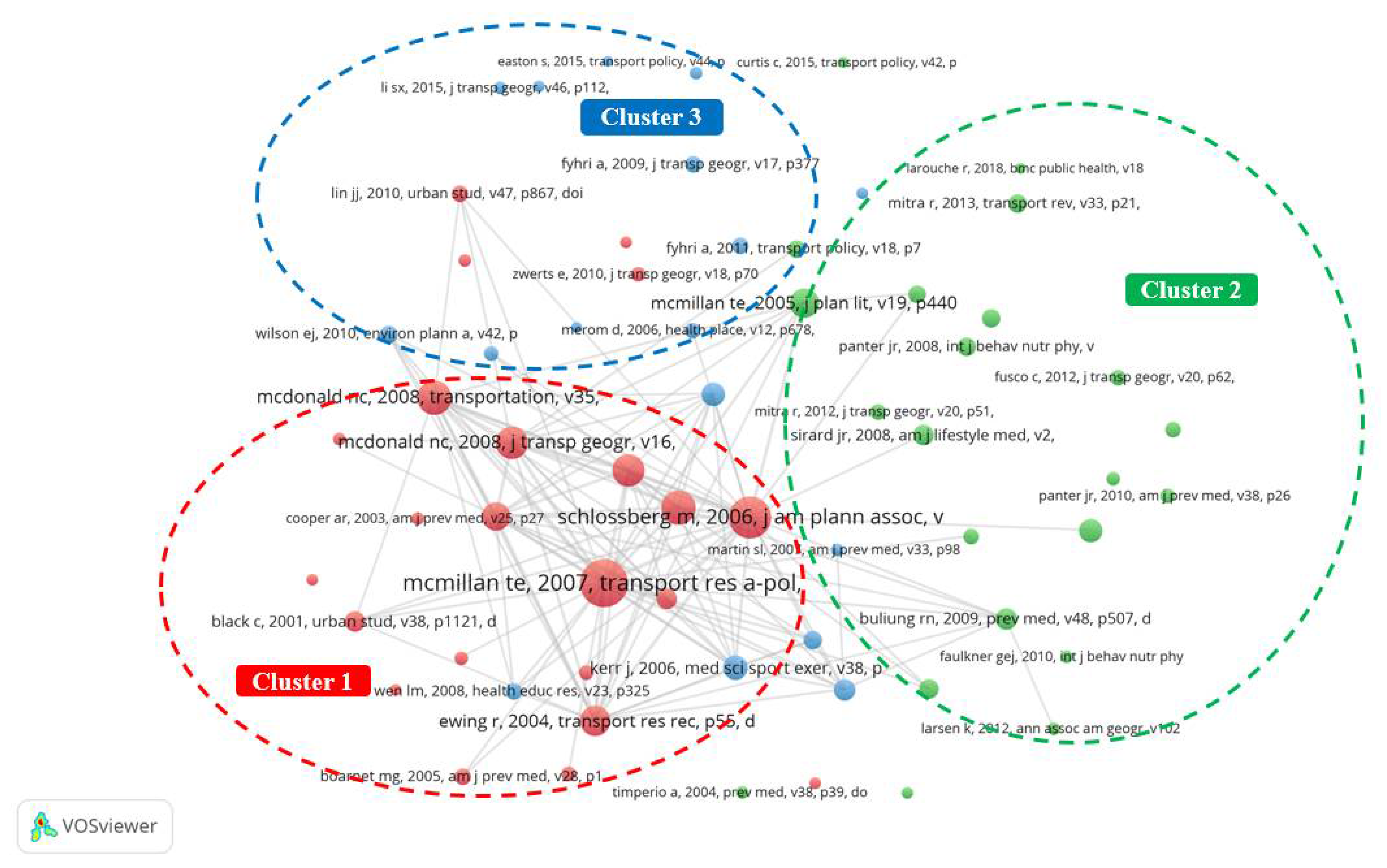
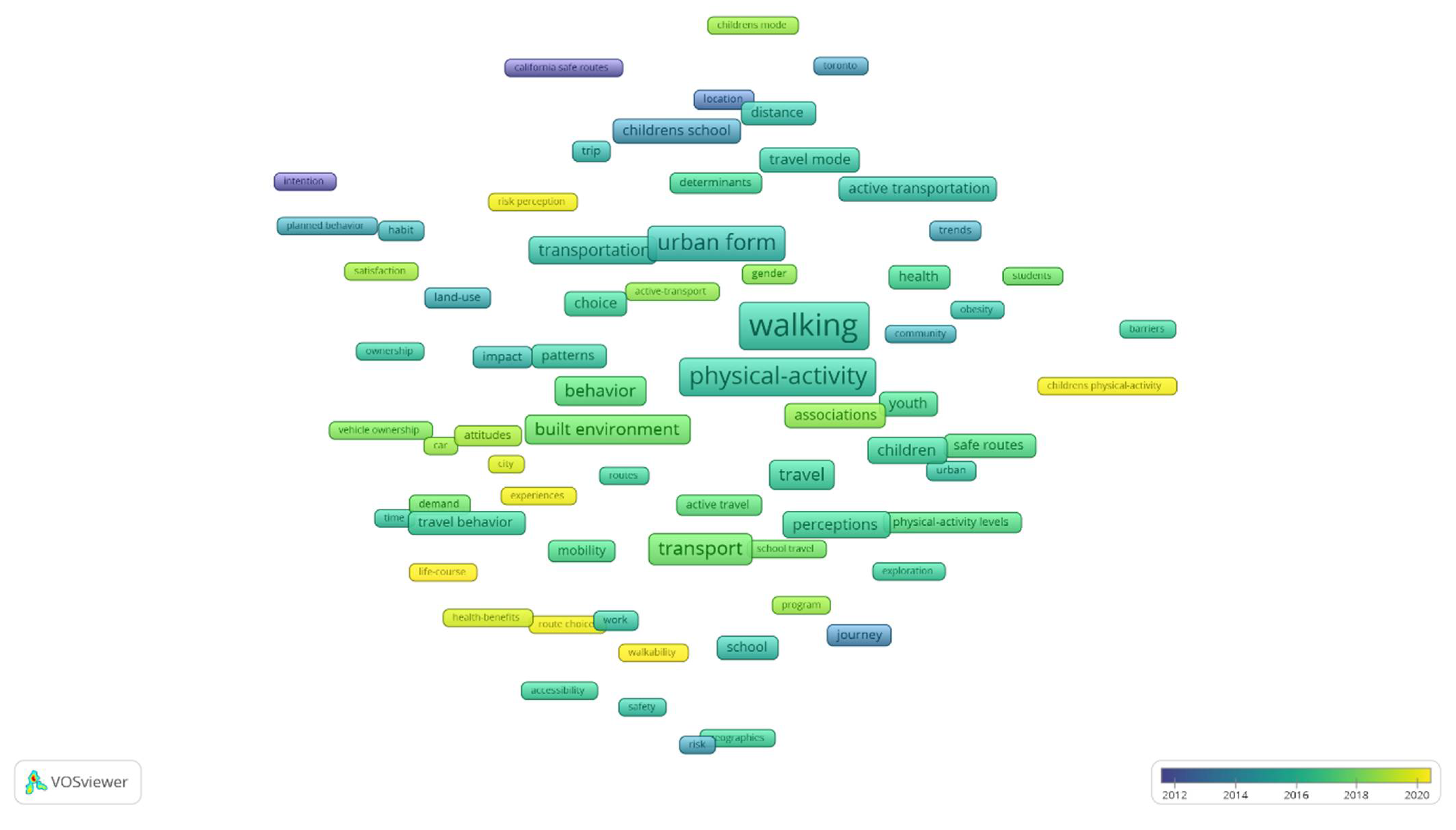
| Checklist Item | Descriptive Characteristics and Findings |
|---|---|
| Study selection |
|
| Results of syntheses | (a) Overview of the articles development trends A total of 457 papers were collected from four databases in this study, with 407 articles and 50 conference papers; the 211 articles from WOS have a citation frequency of 5441, with an average citation frequency of 25.79 and an h-index of 37. |
| (b) Area performance This study collected research from 38 countries and regions; the United States ranked first in the statistical data, while Canada and Australia ranked second and third, respectively; the top 3 productive countries also have high citation frequency and connection strength. | |
| (c) Journal characteristics This study collected literature published in 34 journals; the “Journal of Transport & Health” was the primary source; among the top 10 journals, the number of publications accounted for 81.9% of the selected journals. | |
| (d) The analysis of keywords There are 211 papers, with a total of 885 keywords, in this study. The keywords were divided into three clusters: Cluster 1: Walking to school; Cluster 2: The relationship between active travel to school and students’ health; Cluster 3: The impact of built environment on school travel behaviors. | |
| (e) The analysis of co-citation literature 62 papers were divided into three clusters in the co-citation network.: Cluster 1: the choice of school travel mode; Cluster 2: active travel to school; Cluster 3: school travel behavior and students’ health and route safety. | |
| (f) Highly cited articles All of the highly cited articles came from the top eight countries. Highly cited articles focused on school travel mode choice, active travel to school, and the influence of family interactions on school behavior. |
| Rank | Country | Number | % (R) a | TC b | ATCP c | TLS d |
|---|---|---|---|---|---|---|
| 1 | USA | 59 | 28.0% | 2063 | 35.0 | 24 |
| 2 | Canada | 41 | 19.4% | 1003 | 24.5 | 8 |
| 3 | Australia | 24 | 11.4% | 479 | 20.0 | 17 |
| 4 | England | 21 | 10.0% | 705 | 33.6 | 23 |
| 5 | China | 14 | 6.6% | 308 | 22.0 | 8 |
| 6 | New Zealand | 13 | 6.1% | 133 | 10.2 | 14 |
| 7 | Iran | 13 | 6.1% | 193 | 14.8 | 12 |
| 8 | Germany | 12 | 5.7% | 302 | 25.2 | 5 |
| Rank | Journals | IF (2021) | Number | % (R) a | TC b | ATCP c |
|---|---|---|---|---|---|---|
| 1 | Journal of Transport & Health | 3.613 | 46 | 21.8% | 544 | 11.8 |
| 2 | Journal of Transport Geography | 5.899 | 30 | 14.2% | 1205 | 40.2 |
| 3 | Transportation Research Record | 2.019 | 23 | 10.9% | 321 | 14.0 |
| 4 | Transport Policy | 6.173 | 16 | 7.6% | 587 | 36.7 |
| 5 | Transportation Research Part A: Policy and Practice | 6.615 | 14 | 6.6% | 794 | 56.7 |
| 6 | Travel Behavior and Society | 5.85 | 14 | 6.6% | 176 | 12.6 |
| 7 | Transportation | 4.814 | 11 | 5.2% | 551 | 50.1 |
| 8 | Transportation Research Part F: Traffic Psychology and Behavior | 4.349 | 8 | 3.8% | 228 | 28.5 |
| 9 | International Journal of Sustainable Transportation | 3.963 | 7 | 3.3% | 106 | 15.1 |
| 10 | Transportation Research Part D: Transport and Environment | 7.041 | 4 | 1.9% | 94 | 23.5 |
| Rank | Hot Words | Connection Strength | Co-Occurrence Times |
|---|---|---|---|
| 1 | walking | 681 | 97 |
| 2 | physical activity | 424 | 60 |
| 3 | urban form | 414 | 54 |
| 4 | children | 386 | 57 |
| 5 | built environment | 305 | 42 |
| 6 | mode choice | 274 | 50 |
| 7 | transport | 265 | 42 |
| 8 | neighborhood | 258 | 31 |
| 9 | active transport | 222 | 28 |
| 10 | environment | 220 | 28 |
| 11 | travel behavior | 214 | 34 |
| 12 | perceptions | 206 | 28 |
| 13 | independent mobility | 182 | 25 |
| 14 | travel mode | 178 | 23 |
| 15 | association | 172 | 23 |
| 16 | children school | 171 | 20 |
| 17 | health | 128 | 19 |
| 18 | safe routes | 128 | 17 |
| 19 | mobility | 93 | 16 |
| 20 | land use | 74 | 10 |
Publisher’s Note: MDPI stays neutral with regard to jurisdictional claims in published maps and institutional affiliations. |
© 2022 by the authors. Licensee MDPI, Basel, Switzerland. This article is an open access article distributed under the terms and conditions of the Creative Commons Attribution (CC BY) license (https://creativecommons.org/licenses/by/4.0/).
Share and Cite
Ji, X.; Guan, H.; Lu, M.; Chen, F.; Qin, W. International Research Progress in School Travel and Behavior: A Literature Review and Bibliometric Analysis. Sustainability 2022, 14, 8857. https://doi.org/10.3390/su14148857
Ji X, Guan H, Lu M, Chen F, Qin W. International Research Progress in School Travel and Behavior: A Literature Review and Bibliometric Analysis. Sustainability. 2022; 14(14):8857. https://doi.org/10.3390/su14148857
Chicago/Turabian StyleJi, Xiaofeng, Haotian Guan, Mengyuan Lu, Fang Chen, and Wenwen Qin. 2022. "International Research Progress in School Travel and Behavior: A Literature Review and Bibliometric Analysis" Sustainability 14, no. 14: 8857. https://doi.org/10.3390/su14148857
APA StyleJi, X., Guan, H., Lu, M., Chen, F., & Qin, W. (2022). International Research Progress in School Travel and Behavior: A Literature Review and Bibliometric Analysis. Sustainability, 14(14), 8857. https://doi.org/10.3390/su14148857






